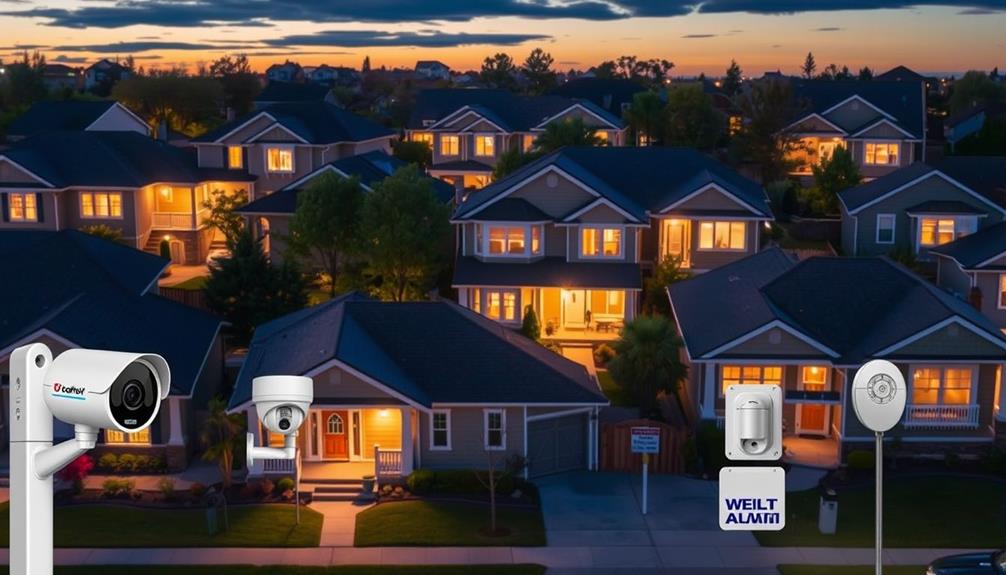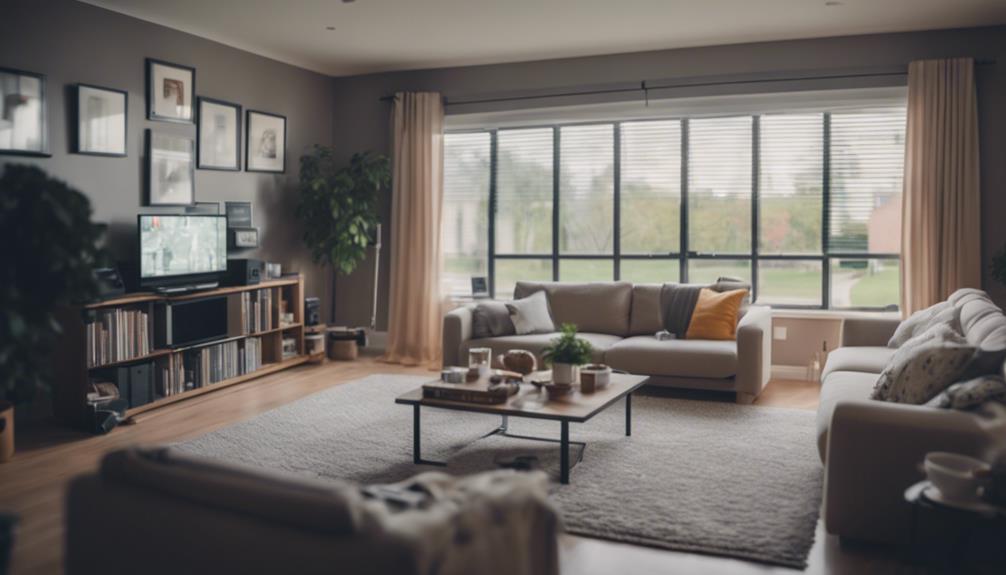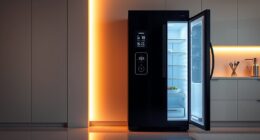In America, around 39 million households, which is about 50% of homes, have security systems. This growing trend shows how committed you are to enhancing your safety and protecting your valuables. Many people opt for smart home technologies and DIY security solutions, expanding their options for home protection. With burglaries still common, having an alarm system can greatly reduce your risk. Over 72% of households own at least one security device, highlighting the importance of staying informed. If you're curious about more statistics and trends in home security, there's plenty more to discover.
Key Takeaways
- Approximately 39 million households in America utilize alarm systems for safety.
- 50% of U.S. homes have security systems, indicating strong safety commitment among residents.
- 72% of U.S. households own at least one security device, reflecting widespread adoption.
- About 21 million U.S. homes have professionally monitored security systems for enhanced protection.
Home Security Market Overview
The home security market in America is booming, with around 39 million households already relying on alarm systems to enhance their safety.
This growing trend isn't just limited to traditional security setups; smart home security systems are increasingly popular among U.S. households. These advanced solutions leverage the latest security technology, allowing homeowners to monitor their properties remotely and receive real-time alerts.
According to the latest home security market report, the global home security systems market is projected to grow considerably, from $40.7 billion in 2020 to $84.4 billion by 2027, at a compound annual growth rate (CAGR) of 8.2%.
You'll also notice a shift towards DIY security systems, which enable you to customize your security without the added costs of professional installation. These systems are often more accessible and appealing, especially for those looking to save money while still protecting their homes.
As the demand for security solutions continues to rise, it's clear that American households are prioritizing safety, making informed decisions about their home security needs. This commitment to security is shaping the future of how we protect our homes and loved ones.
Current System Ownership Statistics

Around 50% of U.S. homes have security systems, highlighting a strong commitment to safety among households. The statistics reveal a proactive approach to crime prevention, especially considering nearly 900,000 burglaries occur annually. Understanding system ownership statistics can help you make informed decisions about your home security.
Here's a breakdown of current ownership:
| Security Device | Number of U.S. Households |
|---|---|
| Alarm Systems | 39 million |
| Video Surveillance Systems | 51 million |
| At Least One Security Device | 72% of U.S. households |
With 72% of households owning at least one security device, it's clear that many people prioritize their safety. Alarm systems and video surveillance systems are among the most popular home security systems, providing peace of mind to residents. By investing in these devices, you're taking a significant step toward reducing the risk of home burglary and enhancing your overall security. As you consider your options, keep these system ownership statistics in mind to better understand the landscape of home security in America.
Motivations for Home Security Systems

When you think about installing a home security system, your main motivations likely center on safety and protecting your valuables.
Many homeowners prioritize their family's well-being, while others focus on safeguarding their possessions.
Understanding these motivations can help you make an informed decision about the right security measures for your home.
Safety Improvement Reasons
Installing a home security system greatly enhances your safety by protecting against potential threats and deterring criminal activity. When you invest in security systems, you're making a proactive choice to improve your overall safety. Here are three key reasons why many homeowners prioritize this protection:
- Protection for Loved Ones: About 27% of homeowners install security systems to guarantee their children's safety while at home or during their absence. Knowing that your loved ones are secure provides peace of mind.
- Deterrent Against Burglars: Homes equipped with security systems are 300% less likely to be targeted by burglars. This significant reduction in risk reinforces the importance of having a robust security measure in place.
- Security During Absences: Frequent absences from home, whether due to travel or long work hours, motivate 26% of individuals to enhance their safety. A reliable home security system allows you to monitor your property, guaranteeing that your home remains secure even when you're away.
Incorporating a home security system not only safeguards your valuable items but also fosters a sense of security for you and your family.
Protection of Valuables
Protecting your valuables is a key motivation for many homeowners investing in security systems, as the financial impact of theft can be devastating. With an average of over $463.5 billion lost in burglaries in 2022, it's clear that safeguarding your valuable items like jewelry, electronics, and important documents is essential.
Consider these statistics highlighting the importance of home security systems:
| Fact | Details |
|---|---|
| % of Homeowners Protecting Valuables | 18% of homeowners install systems for this reason |
| Increased Burglary Risk | Homes without security systems are 300% more likely to be targeted |
| Improved Overall Safety | 74% cite this as a primary motivation |
| Insurance Discounts | 26% benefit from lower premiums due to security systems |
| Average Theft Loss | Over $463.5 billion in 2022 |
Trends in Home Security Technology

Home security technology is rapidly evolving, driven by innovations in smart devices and artificial intelligence that enhance both effectiveness and user convenience. The home security systems market is booming, projected to grow from $40.7 billion in 2020 to $84.4 billion by 2027, with an annual growth rate of 8.2%.
You'll find that the latest home security trends focus on:
- Smart home technologies: With 43% of U.S. households owning at least one smart device, integration with security equipment is becoming standard.
- DIY security systems: Wireless technology has made installation a breeze, making it appealing for homeowners to set up their own systems without needing professional monitoring.
- Video surveillance systems: Demand for networked security cameras continues to rise, emphasizing the need for mobile app control and connectivity.
These advancements not only improve threat detection but also enhance user experience. As technology progresses, you can expect even more features that prioritize convenience, ultimately reshaping how you perceive home security solutions.
Crime Statistics and Security Impact

Crime statistics reveal a compelling link between security systems and a significant drop in burglary rates, making it clear that these measures can greatly enhance your peace of mind. With about 39 million U.S. households relying on home security systems, it's evident that alarms and security devices play an essential role in deterring property crime.
Homes equipped with these systems are 300% less likely to experience burglaries, as over 60% of burglars actively avoid properties with visible security measures. In 2022, the U.S. reported more than 4.3 million larceny-theft incidents, underscoring the persistent need for robust security options.
| Security Measure | Impact on Burglary Rates | Related Crime Rates |
|---|---|---|
| Home Security System | 300% less likely | Reduced property crime |
| Alarms | Strong deterrent | Fewer larceny-theft incidents |
| Visible Security | 60% of burglars deterred | Overall decrease in crime |
| Security Devices | Enhanced protection | Lower theft rates |
Installing a home security system not only protects your property but also contributes to a safer community overall.
Costs of Home Security Systems

When you're considering a home security system, it's important to understand the costs involved.
The average installation expense is around $475, but you might find options ranging from $200 to $1,200.
Plus, don't forget about the monthly monitoring fees, which typically add about $10 to your budget.
Average Installation Expenses
Installing a home security system typically costs around $475, with expenses ranging from $200 to $1,200 based on the features and services you choose. Understanding the average installation cost helps you budget effectively for your security needs.
Here's a quick breakdown of what to expect regarding installation expenses:
- Starter Kits: Basic whole-house starter kits for home security systems average about $460, providing essential components for your setup.
- Control Panels: Essential for system operation, control panels typically add around $130 to your overall costs.
- Professional Installation: Most consumers prefer professional installation, ensuring that your security system is set up correctly, although only 14% opt for self-installed systems.
While these initial costs can seem high, investing in a quality security system can provide peace of mind.
Keep in mind that monthly monitoring fees will add to your overall expense, but understanding installation costs gives you a solid foundation for your home security journey.
Consider your consumer preferences and choose the options that best fit your needs.
Monthly Monitoring Fees
Monthly monitoring fees for home security systems can greatly impact your budget, with average costs around $10 but ranging from as low as $8 to over $50 based on the services you choose.
If you're among the 21 million U.S. homes with professionally monitored security systems, you'll need to factor in these ongoing fees. The level of service often dictates the cost; additional features like video surveillance or mobile app controls can drive up your monthly payments.
However, you might find a silver lining in insurance discounts. Many insurers offer reduced premiums for homes with monitored security systems, which can help offset those monthly monitoring fees.
If you're looking for more affordable options, consider DIY security systems or unmonitored systems. While they eliminate monthly fees, you won't have the same level of professional support.
As a homeowner, it's important to weigh your options. Evaluate your security needs and budget to determine whether a professionally monitored system or a DIY approach is right for you.
In the end, selecting the right system can enhance your peace of mind without straining your finances.
Types of Home Security Systems

Home security systems come in two main types: self-installed (DIY) systems and professionally installed systems, each catering to different needs and preferences. With about 72% of U.S. households using at least one security device, it's clear that many people prioritize home security. DIY systems offer greater flexibility and often come at a lower initial cost, while professionally installed systems provide peace of mind with expert setup and monitoring. The number of home security systems in use continues to rise as more homeowners seek comprehensive solutions to protect their properties. This growing interest is driven by advancements in technology, such as smart integration and remote access, making security more accessible than ever before.
- DIY Systems: These are popular for smaller homes due to their ease of use and cost-effectiveness. You can easily set them up and customize them based on your needs. Plus, they often integrate well with smart home technology.
- Professionally Installed Systems: Around 44% of consumers prefer this option for its extensive features and 24/7 monitoring. Professionals handle the installation, ensuring everything's set up correctly and efficiently.
- Key Features: When choosing security systems, consider video surveillance, alarm systems, and smart home integration. These features are highly sought after and can greatly enhance your home security.
Benefits of Home Security Systems

Investing in a home security system offers numerous benefits that can enhance your safety and peace of mind. One of the most significant advantages is the deterrent effect these systems have on burglars. Homes equipped with security measures are 300% less likely to be targeted, and a staggering 83% of burglars are discouraged from attempting a break-in when they see visible security features.
Additionally, many homeowners enjoy insurance discounts, with about 26% receiving lower rates on their homeowner's insurance due to the presence of a security system. This can make your investment even more worthwhile.
Security cameras play an essential role in providing that peace of mind. In fact, 90% of individuals believe these cameras effectively deter criminal activity, which adds another layer of protection to your home.
Considering that the average cost of a burglary exceeds $2,185, investing in a home security system can save you from significant financial loss. Ultimately, the benefits of home security systems extend beyond safety; they offer both financial incentives and a sense of security, making them a smart investment for any homeowner.
Consumer Behavior and Preferences

In today's market, consumer behavior and preferences considerably shape the demand for various home security systems. When you're considering home protection, it's crucial to understand what drives your choices.
Recent trends reveal three key factors influencing consumer preferences:
- Installation Type: About 44% of you prefer professional installation, valuing the expertise and reliability it brings. However, a significant number are leaning towards DIY security systems, favoring flexibility and cost-effectiveness.
- Technology Integration: Nearly 40% of consumers prioritize remote access capabilities, reflecting a desire for modern solutions that allow you to monitor your home from anywhere. This tech-savvy approach is becoming a standard expectation in security systems.
- Safety Motivation: The top reason for investing in alarm systems is home protection while traveling. A striking 74% of you cite improved safety as a primary motivation for installation, underscoring the importance of feeling secure in your home.
As consumer preferences evolve, the home security market continues to adapt, providing options that cater to diverse needs and lifestyles. This shift highlights the importance of understanding what truly matters to you when choosing the right security system.
Future Trends in Home Security

As consumer preferences shift towards more advanced solutions, the future of home security is poised for significant transformation. You'll notice that the home security systems market is expected to grow from $56.1 billion in 2025 to $93 billion by 2030, reflecting strong market growth.
With an additional 13 million households likely to install alarm systems by 2025, it's clear that consumer demand for security solutions is rising.
The smart home security market, in particular, is thriving, predicted to increase from $32.5 billion in 2025 to $62 billion by 2029. This growth emphasizes the integration of technology and home automation features into security systems, making them more convenient and effective.
Leading companies like Ring, ADT, and Nest are at the forefront, pushing innovations that enhance safety and user experience.
As you explore these trends, consider how smart home technology will reshape your approach to safety. The combination of advanced alarm systems and home automation is set to redefine what security means, creating a more interconnected and responsive living environment.
Frequently Asked Questions
What Percentage of Homes Have a Security System?
About 50% of homes in the U.S. have a security system. If you're considering enhancing your safety, you'll find a variety of options, from alarm systems to video surveillance, readily available to protect your home.
Who Is the Number One Home Security System in the United States?
If you're looking for the top home security system in the United States, it's Ring. With a significant market share, it leads the industry, offering a variety of features that cater to smart home integration.
How Many Homes Use Adt?
If you're considering ADT, you'll find it's one of the largest providers, with millions of homes relying on their security systems. Their 24/7 monitoring and reliable service make them a top choice for homeowners like you.
How Many Security Cameras Are in the United States?
Did you know 86% of Americans believe security cameras are essential for home safety? As of now, there are an estimated 51 million video surveillance systems in the U.S., enhancing security across countless households.
Conclusion
In a world where safety often feels like a fleeting dream, investing in a home security system can be your modern-day shield against the chaos outside.
Just as knights donned armor in times of peril, you can fortify your sanctuary with the latest technology.
With crime rates fluctuating, securing your home isn't just wise; it's essential.
Embrace the peace of mind that comes with knowing you've taken steps to protect what matters most.
Your home deserves it.









